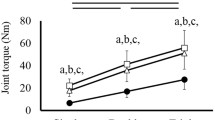Abstract
As a part of a continuing effort to quantify certain information about the mechanical characteristics of parts of the human body, the investigators have made experimental measurements of the stress-strain characteristics of the tendons of three muscles of the human upper extremity. These results have been compared to their previous report concerning the tendon of the M. plantaris. One interesting, provocative and peculiar result was that significant differences in strain under load were observed. Those tendons which are apparently subjected to greater total force in normal body use were found to elongate more than those which are apparently not heavily loaded in normal body use, when tested under equal stresses; that is to say, Young's Modulus,E, for the tendons of M. flexor digitorum profundus and superficialis was found to be significantly smaller thanE for tendons of M. extensor digitorum communis and M. plantaris.
Sommaire
Poursuivant un effort entrepris pour rassembler une certaine quantité de renseignments sur le caractéristiques mécanique de certaines parties du corps humains les chercheurs ont fait des mesures expérimentales sur les caracteristiques force—élongation des tendons de trois muscles du membre supérieur de l'homme. Ces résultats ont été comparés à ceux d'un rapport précédent concernant les tendons du muscle plantaire grêle. Un résultat intéressant, étonnant et très particulier était que des différences notables dans les élongations dûes à des charges furent observées. On constata en effet que les tendons qui sont apparement soumis à un effort total plus important en usage normal s'allongeaient davantage que ceux soumis à un effort moindre, lorsqu'on les observait sous des tensions identiques, c'est-à-dire que le module d'Young,E, pour les tendons des muscles fléchisseurs communs profond et superficiel des doigts fut trouvé notablement plus petit que la valeur deE pour les tendons du muscle extenseur commun des doigts et du muscle plantaire grêle.
Zusammenfassung
Im Zusammenhang einer umfassenden Untersuchung, die zur Quantifizierung bestimmter Informationen über die mechanische Charakteristik von Teilen des menschlichen Körpers angestellt wurde, führten die Autoren experimentelle Messungen der Belastungs-Dehnungs-Charakteristik der Sehnen von drei Muskeln der menschlichen oberen Extremität durch. Die Ergebnisse wurden mit den früher gemachten angaben über den Musculus pläntäris verglichen. Ein interessantes und eigenartiges Ergebnis war die Beobachtung, daß signifikante Unterschiede in der Dehnung bei Belastung bestehen. Die Sehnen, die im Körper normalerweise wahrscheinlich unter stärkerer Belastung stehen, wurden bei gleicher Testbelastung stärker verlängert als solche, die bei normaler Körperarbeit anscheinend weniger belastet werden. Das bedeutet, daß der Youngsche ModulE der Sehnen des M. flexor digitorum profundis und superficialis beträchtlich kleiner als derjenige der Sehnen des M. extensor digitorum communis und M. plantaris ist.
Similar content being viewed by others
References
Biggs, N. L. (1960) Tensile strength of various rat tissues,Anat. Rec.,136, 164–165.
Blanton, Patricia (1964) M.S. Thesis, Department of Anatomy, Baylor University, Dallas, Texas.
Braams, R. (1960) The effect of electron radiation on the tensile strength of tendon,Int. J. Radiat. Biol.,4, 27–31.
Cronkite, A. E. (1936) The tensile strength of human tendons,Anat. Rec.,64, 173–186.
Davisson, L. (1936) Tensile strength, rupture and regeneration of tendons,Annls Chir. Gynaec. Fenn.,43 (Suppl.5), 61–66.
Gerston, J. W. (1955) Effect of ultrasound on extensibility of tendon.Am. J. phys. Med.,34, 362–369.
McMaster, P. E. (1933) Tendon and muscle ruptures; Clinical and experimental studies on causes and location of subcutaneous ruptures.J. Bone Jt Surg.,15, 705–722.
Takigawa, M. (1933) Study upon strength of human and animal tendons,J. Ryoto Pref. Med. Univ.,53, 915–934 (Cited by H. Yamada).
Walker, Jr., L. B. andHarris, E. H. (1964) An instrument for the measurement of cross sectional area of small flaccid, moist fibrous bundles (e.g. tendon),Anat. Rec. 148, 407–408.
Walker, Jr., L. B., Harris, E. H. andBenedict, J. V. (1964) Stress-strain relationship in human cadaveric plantaris tendon; a preliminary study.Med. Electron. biol. Engng.,2, 31–38.
Yamada, H., M.D. (1963) Human Biomechanics, private communication.
Author information
Authors and Affiliations
Additional information
This research was supported, in part, by a grant from the U.S. Department of Health, Education and Welfare, Grant No. NB 04943-01.
Rights and permissions
About this article
Cite this article
Harris, E.H., Walker, L.B. & Bass, B.R. Stress-strain studies in cadaveric human tendon and an anomaly in the young's modulus thereof. Med. & biol. Engng. 4, 253–259 (1966). https://doi.org/10.1007/BF02474798
Received:
Revised:
Issue Date:
DOI: https://doi.org/10.1007/BF02474798




